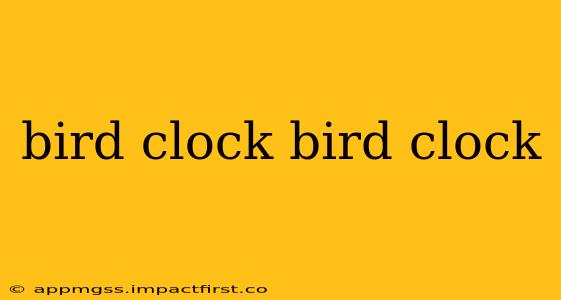Bird clocks, while not literal clocks in the traditional sense, refer to the remarkable internal clocks possessed by birds that govern their daily and seasonal activities. This fascinating biological mechanism allows birds to precisely time crucial behaviors like migration, breeding, foraging, and sleeping. Understanding bird clocks offers a deeper appreciation for the complexity and adaptability of avian life. This guide will delve into the intricacies of avian timekeeping, answering many common questions surrounding this captivating subject.
What is a Bird Clock (Circadian Rhythm)?
A "bird clock" is essentially a circadian rhythm – an internal biological clock that regulates a roughly 24-hour cycle of physiological processes. This internal clock isn't a physical organ; it's a complex interplay of genes, neurons, and hormones within the bird's brain, primarily located in a region called the suprachiasmatic nucleus (SCN). This SCN acts as the master clock, synchronizing various bodily functions to the daily light-dark cycle.
How Accurate are Bird Clocks?
Bird clocks are remarkably accurate, enabling birds to anticipate daily events like sunrise and sunset with astonishing precision. This accuracy is vital for optimizing foraging opportunities, avoiding predators, and coordinating social interactions. While primarily influenced by light, other environmental cues like temperature and social interactions can also subtly influence the timing of these internal clocks. The degree of accuracy can vary slightly between species and even individuals within a species, depending on environmental conditions and individual physiological differences.
Do All Birds Have a Bird Clock?
Yes, all birds possess an internal circadian clock. However, the specific mechanisms and their influence on behavior can differ across species. Migratory birds, for example, exhibit particularly sophisticated circadian rhythms, guiding their long-distance journeys and timing their arrival at breeding grounds. Even non-migratory birds rely on their internal clocks to synchronize their daily routines with the optimal times for feeding, mating, and resting.
What Environmental Cues Influence Bird Clocks?
The primary environmental cue that synchronizes a bird's internal clock is light. The duration and intensity of daylight significantly impact the timing of various physiological processes. However, other environmental factors, such as temperature and social cues, also play a role, although to a lesser extent. These secondary cues can fine-tune the bird's clock, ensuring optimal adaptation to the specific environment.
How Do Bird Clocks Affect Migration?
Bird clocks are critical for successful bird migration. They regulate the timing of migratory restlessness (Zugunruhe), a pre-migratory behavioral state characterized by increased activity and anxiety. The internal clock helps birds anticipate the favorable conditions for migration, ensuring they depart at the optimal time to maximize their chances of survival and reproductive success. The precise timing of departure and arrival is often crucial for accessing resources and avoiding harsh weather conditions.
Can Bird Clocks be Disrupted?
Yes, bird clocks can be disrupted. Artificial light, especially at night, can significantly interfere with their natural rhythms. This disruption can lead to various negative consequences, including reduced reproductive success, impaired navigation during migration, and increased susceptibility to predation. Environmental changes, such as habitat loss and climate change, can also impact the accuracy and effectiveness of bird clocks, further underscoring the importance of conservation efforts.
How are Bird Clocks Studied?
Scientists use various methods to study bird clocks, including laboratory experiments involving manipulation of light cycles and the measurement of hormone levels and gene expression. Field studies, utilizing tracking devices and behavioral observations, also provide valuable insights into the role of circadian rhythms in natural environments. By combining laboratory and field approaches, researchers are continually refining our understanding of the complex mechanisms governing avian timekeeping.
This exploration into the fascinating world of bird clocks highlights the intricate biological mechanisms that govern avian behavior. Further research continues to unveil the complexities of these internal timekeeping systems, furthering our appreciation for the remarkable adaptations found in the natural world.
